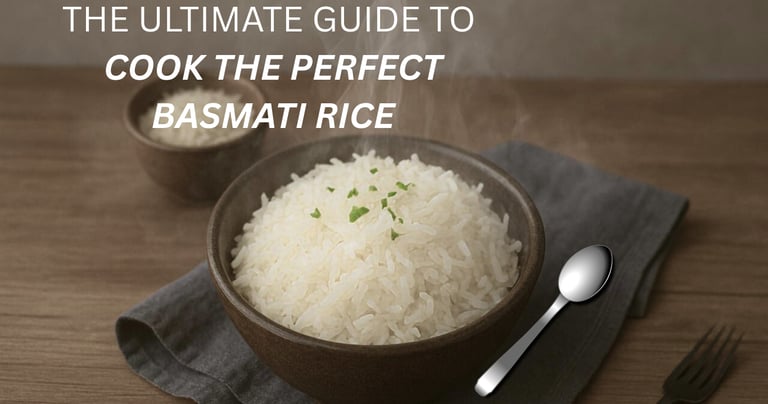The Ultimate Guide to Cook Perfect Basmati Rice
New to cooking basmati rice? Don’t stress—I’ve got you! In this guide, I’ll walk you through the simple steps to cook soft, fluffy, and non-sticky basmati rice every single time. No complicated techniques, just a foolproof method anyone can follow!
4/17/20253 min read


1.Preparing Basmati Rice for Cooking
Rinsing and Soaking:
Why Rinsing is Essential for Basmati Rice Rinsing basmati rice removes excess starch, which can cause the rice to become sticky during cooking. This step is crucial for achieving the desired fluffy texture.
Step-by-Step Guide to Rinsing Basmati Rice
1. Place the rice in a fine-mesh strainer.
2. Rinse under cold running water until the water runs clear.
3. Let it drain for a few minutes.
Benefits of Soaking Basmati Rice Before Cooking : Soaking basmati rice for 30 minutes to an hour helps to soften the grains and reduces cooking time. It also enhances the texture, making the rice fluffier.
Measuring Rice and Water: Standard Rice-to-Water Ratios for Basmati Rice A common ratio for cooking basmati rice is 1 cup of rice to 1.5 cups of water. However, this can vary based on the cooking method and personal preference. Adjusting Ratios for Different Cooking Methods For stovetop cooking, the 1:1.5 ratio works well, while a rice cooker may require slightly less water. Experimenting with ratios can help you find the perfect balance.
Tips for Measuring Accurately Using a measuring cup ensures consistency. Always level off the rice and water for precise measurements.
2. Cooking Methods for Basmati Rice
2.1 Stovetop Cooking
Step-by-Step Instructions for Stovetop Cooking
1. Rinse and soak the rice as described earlier. 2. In a pot, combine the soaked rice and water. 3. Bring to a boil, then reduce heat to low and cover.
4. Cook for 15-20 minutes, or until water is absorbed.
5. Remove from heat and let it sit for 5 minutes before fluffing with a fork.
Tips for Achieving the Perfect Texture Avoid lifting the lid during cooking, as this can release steam. Letting the rice rest after cooking allows it to finish steaming.
Common Mistakes to Avoid * Not rinsing the rice, leading to stickiness. * Using too much water, resulting in mushy rice.
2.2 Rice Cooker Method
How to Use a Rice Cooker for Basmati Rice 1.Rinse and soak the rice. 2. Add the rice and water to the rice cooker, following the recommended ratio. 3. Turn on the rice cooker and let it do the work.
Advantages of Using a Rice Cooker Rice cookers simplify the process, ensuring consistent results without the need for constant monitoring.
Troubleshooting Common Rice Cooker Issues If the rice is undercooked, add a little more water and cook for a few more minutes. If it’s overcooked, reduce the water next time.
2.3 Instant Pot Method
Benefits of Cooking Basmati Rice in an Instant Pot The Instant Pot cooks rice quickly and efficiently, making it a great option for busy cooks. It also retains more nutrients compared to traditional methods.
Detailed Instructions for Instant Pot Cooking
1. Rinse and soak the rice.
2. Add the rice and water to the Instant Pot (1 cup rice to 1 cup water).
3. Seal the lid and set to high pressure for 6 minutes.
4. Allow for natural release for 10 minutes before opening.
Adjusting Cooking Times for Different Quantities
For larger quantities, you may need to increase the cooking time slightly, but the water-to-rice ratio generally remains the same.
FAQs
1. What is the best way to cook basmati rice? The best way is to rinse and soak the rice, then cook it using your preferred method, ensuring the right water-to-rice ratio. 2. How long should I soak basmati rice before cooking? Soaking for 30 minutes to an hour is ideal for achieving the best texture. 3. Can I cook basmati rice without soaking it? Yes, but soaking improves the texture and reduces cooking time. 4.What is the ideal water-to-rice ratio for basmati rice? A common ratio is 1 cup of rice to 1.5 cups of water, but this can vary based on the cooking method. 5. How can I prevent basmati rice from becoming sticky? Rinsing the rice thoroughly and using the correct water-to-rice ratio will help prevent stickiness.
